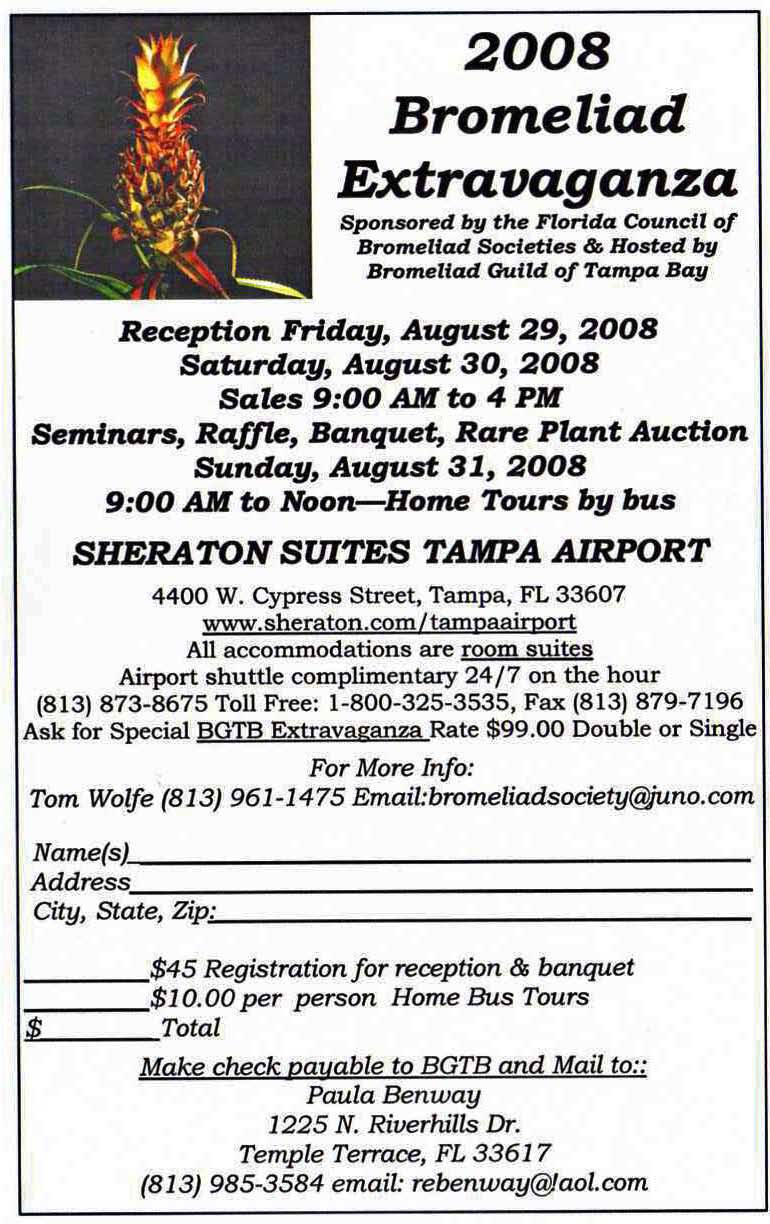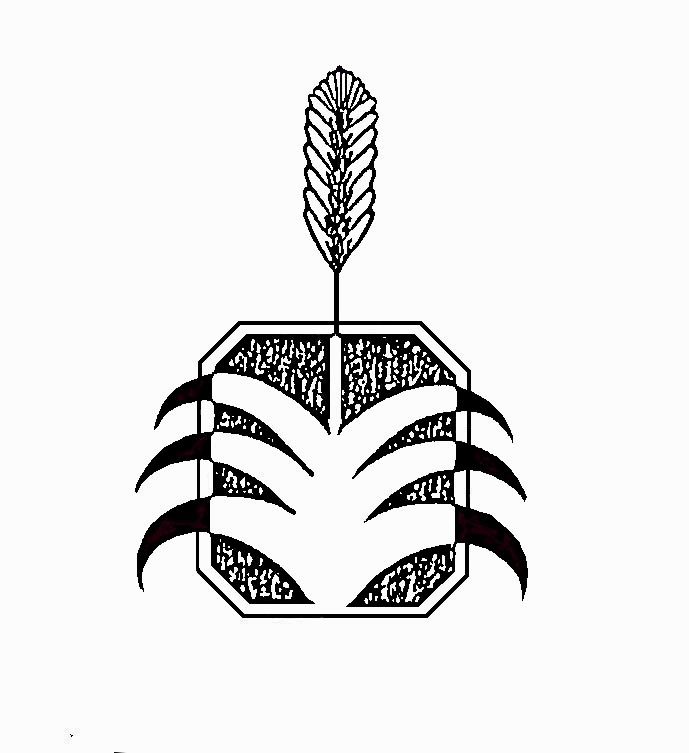
Happy 4th of July, 2008!
President – Nina Leggett - 386/673-0550
Vice President – Joan Campbell – 672-7382
Secretary – Calandra Thurrott – 761-4804
Treasurer – Evelyn Santus – 615-1138
______________________________________________________________________
This month’s meeting
Our guest speaker this month is George Aldrich of Ocala. Many of you know George form our field trip to his nursery "Plants and Things", but did you know that both George and his wife Irene are BSI accredited master judges? George will be bringing plants for sale also, so this is a great opportunity to add some first class bromeliads to your collections!
Summer is definitely here now
…and that means that you should be working with your bromeliad collection to make the most of this active growing season. July is traditionally the month for stepping up your fertilization schedule to match the increasing rainfall and increasing temperatures. Of course, this is if you fertilize your plants – a lot of people don’t and this is probably a subject that we should discuss at some time in the future. Bromeliads are growing more rapidly now, so you need to pay attention to them to avoid uneven growth. This means that if one side gets more sun than the other, you will need to turn your plants for even growth. It also means that if those pups still attached to their mother plants are large enough, now is a good time to remove them before they get too big and start developing a lop-sided look about them.
Keep an eye out for lubber grasshoppers during these summer months. One of these babies can reduce your prized Guzmania or Vriesea to shreds in a very short time. Look for cute little black grasshoppers with a yellow stripe on each side. These are the young ones and may appear as a group of 10 – 20 when they first hatch. Soon enough these mature into the 2 to over 3 inch long yellow, prehistoric- looking monsters that devour everything in their path. The University of Florida IFAS says the following about these grasshoppers:

Adult eastern lubber grasshopper, Romalea microptera (Beauvois), dark color phase.
Photograph by: John Capinera, University of Florida
Eastern lubber grasshoppers possess a variety of abilities to defend themselves. Their bright color pattern is a warning to predators that the lubber contains toxic substances. Indeed, there are several records attributing the demise of individual birds to failure to exercise caution when selecting prey items. Also small mammals such as opossums have been known to vomit violently after ingesting a lubber, and to remain ill for several hours.(!!!) However, shrikes are reported to catch and kill lubbers.
If the red, yellow, and black coloration fails to keep a predator at bay, then the lubber may secrete a foamy spray from the thoracic region (the portion of the body where the legs and wings are attached.) This spray consists of a number of compounds, some of which, are irritants. This bubbly froth is accompanied by a relatively loud, frightful hissing sound. The insect contracts the abdomen to force air out of the spiracles along with the defensive secretion. The sound is produced as the spray is being forced out of these tiny holes in the thorax called spiracles. Eastern lubbers, like most all grasshoppers, can also regurgitate recently consumed plant material. This regurgitant is mostly liquid and has a dark brown color. This is commonly referred to as "tobacco spit." The tobacco spit is partially digested food material along with some semi-toxic compounds from the insect's crop region. This substance can easily stain clothing.
All I can say is that when something makes a possum sick, that’s one bad tasting insect! What can we do to control this pest? When they are still in the nymph stage (the cute little black with yellow stripes guys) you can simply pick them off the plant and drop them into a container of soapy water. You have to be quick though, because the rest of the group will scatter and hide when you single out one of a recently hatched egg cluster. Once they reach adult size, they’re easier to see and grab and then can be disposed of under the heal of your shoe or by using the two brick method – place the grasshopper on one brick and quickly cover it with the second brick, using a strong downward motion with brick #2.
Back to Basics – "D" is for…
Raise your hand if you’ve ever heard of Prince von Salm-Dyck. What? I don’t see many hands out there. He was a Prussian (now raise your hand if you can find Prussia on a map) botanist. First a count and later promoted (is that how it works?) to prince, he built greenhouses at his castle and published several botanical treatises on succulents…and that’s where the link to bromeliads comes in. Salm-Dyck was honored by having his name given to this group of prickly bromeliads. With a full name listed in Wikipedia as "Maria Joseph Ignaz Franz Anton Hurbert de Salm Reifferscheidt-Dyck", I’ve got to imagine that when this Genus name was coined, consideration was given to fitting the name on a typical plant tag so it was shortened to Dyckia – but of course, that is just speculation on my part.
This group of terrestrial plants is made up of approximately 100 species found in the more arid regions of South America. Their stiff leaves are heavily armed with spines and arranged in a rosette. When in bloom, typically yellow or orange flowers are borne on tall, unbranched spikes that start horizontally from the base of the leaves rather than from the center of the rosette as in most bromeliads. Most of these are Spring or Summer bloomers in our area.
When selecting Dyckias for your home collection choose wisely and give some thought to the size your plant will ultimately attain. Some of these plants can be quite large and intimidating like Dyckia encholirioide - a 30" diameter beast from Brazil while others, like Dyckia marnier-lapostollei are full grown with leaves only 5" long –a much better behaved plant! Try planting Dyckia encholirioide by the entrance to your front door and be prepared to spend your spare time in small claims court paying for torn clothing. You may even find yourself on the "do not deliver" list of your favorite pizza place. All kidding side, these can be very interesting plants and the blooms really are quite attractive. Many Dyckia species and hybrids are desirable additions to anyone’s bromeliad collection and are often seen in succulent collections as well.
Culture techniques, as you might expect, are somewhat different for these terrestrials from the standard, epiphytic bromeliad recommendations. Always keep in mind that terrestrial bromeliads need to either be in pots or planted directly in the ground. Most attempts to mount Dyckias on pieces of driftwood will be doomed to failure. This is definitely not a group of plants that you will see mounted in seashells and adorning refrigerators.
Pots: These plants have very extensive root systems and need to be grown in a larger pot than one you might choose for a similarly sized epiphytic bromeliad, which may use the pot and mix only for support. In seems as though the roots begin poking through the drain holes in the bottom of your pots in no time at all, so be prepared to repot to a larger size container before things really get out of hand. As far as type of pot – go for the varieties that have some depth to them. This is one of the few situations where azalea-style, shallow pots are not the best choice.
Watering: Although Dyckias originate from arid parts of S. America, they benefit greatly from generous watering schedules. This isn’t necessarily as easy as it may seem since the large number of spiny leaves may completely cover the surface of a pot – resulting in water quickly running off and never finding its way to the potting mix. You may also find that the roots completely fill the pot and water quickly passes down and out the drain holes with little or no retention. If either of these is a problem for you, consider placing the pot on a saucer and keeping water in the saucer. Just think of your Dyckia as an oversized, very spiny African Violet and you shouldn’t have any trouble at all! Allow the plant roots to dry out though and you will be plagued by brown leaf tips!
Fertilizing: As you might expect from any plant that grows quickly, Dyckias respond well to a good fertilization program. They’re not very choosy about what kind of fertilizer you use, but these are some of the few bromeliads that don’t really benefit much from foliar feeding. Use a slow release type fertilizer in the mix instead.
Propagation: There will be blood -you’re going to hurt yourself separating these pups! They often don’t separate easily, they’re very spiny, and if you don’t stick yourself several times separating the pups, you’ll probably suffer a few punctures as you place the pup in a fresh pot and add the potting mix. Sort of takes the mystery out of why you so often see multiples in one pot at bromeliad shows, doesn’t it?
If you are interested in adding one or more of this interesting group of bromeliads to your collection, keep an eye out for Dyckia fosteriana(nice silvery leaves, attractive bloom), D. ‘Cherry Coke’ (one of the nicer hybrids with bright red leaves), D. ‘Naked Lady’ (spineless hybrid w/thick, fleshy dark green leaves).or my favorite-D. choristaminea (small plant w/very thin spineless leaves – produces a nice yellow inflorescence w/fragrant flowers).
If you haven’t already, make a place in your collection for a few Dykias or their cousins the Hechtias (they look alike, but that’s where the resemblence ends). They may be spikey, but there is an undeniable attraction to these plants!
Presidents Corner
The rainy season has finally arrived and oh how the "brommies" love it. The dust and dirt have been washed away and the colors are beautiful. Almost every day I am finding a plant that I hadn’t really noticed before, all of a sudden they are popping out and shouting "Look at me, look at me". It doesn’t matter how much I water them during the dry spells the colors just don’t shine, but when it rains it really does something to them and their true colors shine through. I hope you have all been inspired to get out and separate some of your pups, bring them to the meeting and we can have another great raffle this month. Also don’t forget about "show and tell’ for any of your plants that have been shouting "Look at me".
See you all there.
Nina

If you haven’t already, use the registration form above to register for this year’s Extravaganza in Tampa. It’s shaping up to be an outstanding event and rooms are going fast, so get your registration in now!

…and, it’s never too early to register for a World Conference – get your registration in now and take advantage of the lower rates!
